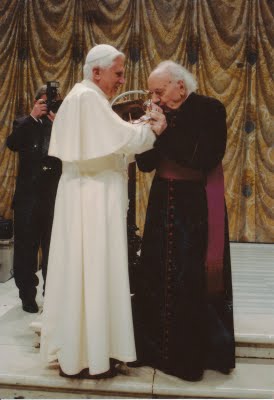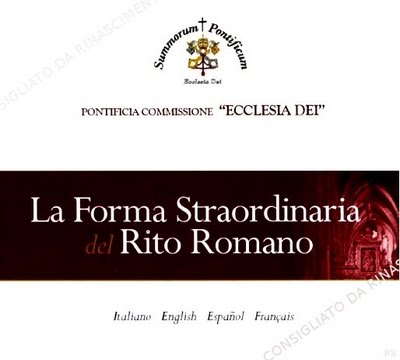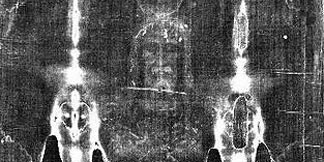
Source: Rorate Caeli
An interview with Mons. Domenico Bartolucci, Maestro Perpetuo of the Sistine Chapel under five Popes. The original Italian can be found here.From the remarkable Italian Catholic blog, Disputationes Theologicae:
August 12, 2009
Mons. Bartolucci speaks about the liturgical reform and the “reform of the reform”
The liturgical reform of the 1970-ies is today taking up much space in the theological discussions, because liturgy and theology are mixed up in a – may we venture to say so – “transcendental relation”. It is not possible to discuss the one without taking up the other, if one does not want to fall into that theology of watertight compartments that was in use in the 1950-ies. Today it is necessary – in the wake of a more vast debate in which we engage ourselves – to formulate an open and straightforward analysis of what has happened and take an appropriate attitude towards the practical remedies and above all remedies that are “realizable” (realizzabili) as Saint Pius X used to repeat. Upon the request of so many of our readers, our Editorial Office also would like to occupy itself with the argument, if possible avoiding the repetition of the methodological errors of the past. Therefore it is our wish to initiate the true transmittance of the authentic Tradition.– basing ourselves on the testimony of those who have known the past, because of their age and their prestige, and not only because of their authority. As liturgy is also practical science, we have not wished to start off with pontificating “liturgists” who say they have read so and so many books and codices, but rather take the matter up with someone who has lived and touched the liturgy as nobody else has, because he has prepared, repeated, coordinated and known the religious ceremonies in his Tuscan countryside, ceremonies which concluded with the “Messa in terza” (a mass celebrated by three i.e. Solemn Mass — CAP) and the unfailing processions with a musical band, as well as the splendors of the “Cappella Papale” in the Sistine chapel. We have the honor of introducing to you Monsignor Domenico Bartolucci, in an interview done by us lately. He was born in 1917 in Borgo San Lorenzo (Florence)., Tuscan by birth, Roman by pontifical summons, in 1952 he became substitute next to Perosi in the Sistine Chapel and from 1956 he became its Maestro Perpetuo. On the 24th of June, 2006 the reigning pontiff organized a special ceremony in honor of the musician (see the picture above), in order to consecrate “ad perpetuam rei memoriam” his closeness to the great master. During the occasion the Pope said: “ sacred polyphony, especially the one belonging to the Roman school, is a legacy which we must preserve with care (..); a genuine updating of the sacred music can only take place within the great tradition of the past of the Gregorian chant and of the sacred polyphony”. S.C.
INTERVIEW WITH MONSIGNOR. DOMENICO BARTOLUCCI
by Pucci Cipriani and Stefano Carusi
A meeting with Monsignor Domenico Bartolucci, the distinguished Mugellan musician, Maestro Emeritus of the Sistine Chapel, admirer, friend and collaborator of Benedict XVI.
It is a sunny afternoon on the green hills of the Mugellan landscape, when we arrive on the Roman church of Montefloscoli, in the antique rectory full of memories the Maestro Perpetuo of the Sistine Chapel is enjoying the fresh air, behind him a framed photo of the hug the reigning pontiff is giving Monsignor Domenico Bartolucci, the successor of Lorenzo Perosi in the Sacred Palace. On his writing-desk the now-famous book of Monsignor Brunero Gherardini: “Il Concilio Vaticano II- un discorso da fare” (“The Second Vatican Council – a debate to be started”), edited by Edizioni Casa Mariana.
It is on the subject of the liturgical reform that we start our conversation with the Maestro, with Domenico Bartolucci, who in liturgical and musical matters has been at ease working and giving counsel to five popes and who is a friend and collaborator of Benedict XVI, whose work he says is “an immense gift to the Church, if only they would let it work”.
Maestro, the recent publication of the Motu proprio “Summorum Pontificum” has brought a gust of fresh air into the desolate liturgical panorama which surrounds it. Even you may now celebrate the Mass of all time (“messa di sempre”.)
To tell the truth, I have always and without interruption celebrated it since my ordination … on the contrary, I sometimes found it difficult to celebrate according to the modern rite, even if I never said so.
The Mass which never was abolished, is it not?
Those are the words of the Holy Father even if some people pretend not to understand and even if many in the past have argued that the opposite is true.
Maestro, you have to admit to those who are denigrating the old Mass that it is not a Mass open to participation.
So that you won’t think that I’m just saying anything, I know how participation in old times was like, both in Rome, in the (St. Peter’s) Basilica and outside it, for instance down here in Mugello, in this parish, in this beautiful countryside, which was then populated by people strong in faith and full of piety. During Sunday Vespers the priest could just start singing “Deus in adiutorium meum intende” and thereafter fall asleep on his seat to wake up only at the “chapter”, the peasants would have continued alone and the heads of the family would have intoned the antiphon!
Do we see a veiled polemic, Maestro, in your confrontation with the current liturgical style?
I do not know, if you have ever been at a funeral and witnessed those “hallelujahs”, hand-clapping, giggly phrases, etc. One really asks oneself if these people have ever read the Gospel. Our Lord himself cried over Lazarus and his death. Here now, with this oily sentimentalism, nothing is respected, not even the suffering of a mother. I would like to show you how the people in old times participated in a Funeral Mass and how in the midst of that compunction and devotion, the magnificent and tremendous “Dies Irae” was intoned.
Was the reform not done by people who were conscious of what they were doing and well educated in the teachings of the Roman Church?
I beg your pardon, but the reform was done by arid people, arid, arid, I repeat it. And I knew them. As for the doctrine, Cardinal Ferdinando Antonelli himself, once said, I remember it well: “How come that we make liturgists who know nothing about theology?”
We agree with you, Monsignore, but is it not true that the people did not understand….
Dearest friends, have you never read Saint Paul: “It is not important to know anything but what is necessary”, “it is necessary to love knowledge ad sobrietatem”. At this rate, after a few years people will pretend to understand “transubstantiation” in the same way as they explain a mathematical theorem. But just think of it that not even the priest may quite understand this mystery!
But how could it have come to this twisting of the liturgy?
It became a kind of fashion. Everybody talked about it, everybody “was renewing”, everybody was trying to be like popes (tutti pontificavano) in the wake of sentimentalism, of eagerness to reform. And the voices that raised themselves to defend the two thousand year old Tradition of the Church, were cleverly hushed. There was the invention of a kind of “people’s liturgy” … when I heard these refrains, it came into my mind something which my professor at the Seminary used to say: “the liturgy is something given by the clerics to the people” (“la liturgia è del clero per il popolo”). It descends from God and does not come up from the bottom. I have to admit, however, that this foul-smelling appearances have made themselves a bit more rare. The young generations of priests are maybe better than those who came before them, they do not have the ideological fury of an iconoclastic ideology, they are full of good feelings, however they lack in education.
What do you mean, Maestro, when you say “they lack in education”?
It means that they need it! I am speaking of the structure that the wisdom of the Church had so delicately chiseled in course of centuries. You do not understand the importance of the seminary: a liturgy that is fully lived, the orderly articulation of the different periods of the year and all this experienced in social communion with the brothers… Advent, Lent, the big feasts that follow after Easter. All of this is educational and if you only knew how much!
A foolish rhetoric wants to depict the seminary as something which spoils the priest, that the seminarians, remote and far away from the world, remain closed in themselves and distant from the people. This is pure imagination, invented by people who wish to dissolve an age-old formative richness and replace it with emptiness.
Let us return to the crisis of the Church and to the fact that so many seminaries have closed down, do you, Monsignore, support a return to the continuation of Tradition?
Look here, to defend the old rite is not the same as being a worshipper of ancient times; it is to be “eternal”. You see, when one gives the traditional mass names like “Mass of Saint Pius V” or “Tridentine” one is wrong, it makes it seem as if it is a mass belonging to a certain epoch. It is our Mass, the Roman universal Mass, valid everywhere and in all times, a single language spoken from the Oceania to the Arctic’s. Concerning the continuity in time, I would like to tell you an episode. Once we were together with a Bishop whose name I forgot, in a small church in Mugello, when there came the sudden notice that a brother of ours had died. We suggested that we at once celebrate a Mass, but then we realized that we only had old Missals at hand. The Bishop refused categorically to celebrate. I will never forget it and I repeat that the continuity of the liturgy means that – except for small details – it can be celebrated today, with that old dusty missal standing on a bookshelf and which for four centuries or more has served my predecessors.
Monsignore, there is much talk about a “reform of the reform” which could take away the deformities that came in the 70-ies.
The question is rather complicated. That the new rite had deficiencies is by now becoming evident for everybody, and the Pope has many times said and written that we must “keep what is ancient” (guardare all’antico). However we must beware of the temptations of introducing hybrid measures. The liturgy with a big “L” is the one that comes to us from centuries back, it is the reference, it is not the debased liturgy which holds so many compromises “that make God sad and the enemy happy” (“a Dio spiacenti e a l’inimici sui”)
What do you mean, Maestro?
Let us for instance take the innovations in the seventies. Some ugly songs in beat that were in vogue in the churches in 1968, are today already archeological pieces. Giving up perennity and emerging oneself in time, means that one is condemned to the fads of fashion. In this connection I come to think of the Reform of the Holy Week in the 1950’s, made with some hurry under the pontificate of a Pope Pius XII who was already exhausted and tired. Only some years later, under Pope John XXIII who in liturgical matters was of a convinced and moving traditionalism, came a telephone call to me from Mons. Dante, Master of Ceremonies of the Pope, who told me to prepare the “Vexilla Regis” for the coming celebration on Good Friday. I was somehow taken aback and answered: “They have forbidden me to do it”. The answer was: “But the Pope wishes it.” In a few hours I organized the repetitions of the songs and very happily we sang again the same songs which the Church had sung in many centuries on that day. All this only to say that when one distances oneself from the liturgical context those voids become difficult to fill and you can be sure they are noticed! In front of our liturgy of many centuries we should contemplate it and venerate it and remember that in our mania for “improvements”, we only risk doing great damage.
Maestro, what role does music play in this process?
It has an incredibly important role for many reasons. The affected “Cecilianism” to which certainly Perosi was no stranger, with its tones that were so mild and enticing to the ear had introduced a new romantic sentimentalism, which had nothing to do, for instance, with the eloquent and solid physicality of Palestrina. Some extravagant deteriorations introduced by Solesmes had cultivated a subdued gregorianism, which also was the fruit of a pseudo-restauring passion for the Medieval ages, which were so popular in the nineteenth century.
The idea of an opportunity to recuperate the archeological vein, both in music and liturgy, of a past, from which the so called “oxen centuries” (seculi bui) of the Council of Trent separated it ….. in short an archeology which has nothing at all to do with Tradition and which wishes to restore something which maybe never existed, is a bit similar to certain churches restored in the “pseudoromantic” style of Viollet-le-Duc.
What does it mean, Monsignore, when in the musical field you attack Solesmes?
This means that the Gregorian chant is modal, not tonal and not rhythmical, it has nothing to do with “one, two, three, one, two, three”. We should not despise the way people sung in our cathedrals and replace it with a pseudo-monastic and affected murmuring. A song from the Middle Ages is not interpreted with theories of today, but one should go about it as it was then. Moreover the Gregorian chant of another historical time could also be sung by the people, sung using the force with which our people expressed their faith. Solesmes never understood this, but we should recognize the learned and large philological work executed on the old manuscripts.
Maestro, how far have we come in our days with the restoration of Sacred Music and the Liturgy?
I cannot deny that there some signs of restoration, but I still can see that there persists a certain blindness, almost a complacency for all that is vulgar, coarse, in bad taste and also doctrinally temerarious. Most important, do not ask me, please, to make a judgement on the guitar-players and on the tarantellas which are sung during the Offertory.….The liturgical problem is serious, do not listen to the voices of those persons who do not love the Church and who oppose the Pope and if you want to cure the sick then remember that the merciful doctor makes the wound purulent (fa la piaga purulenta).
Filed under: Uncategorized | Leave a comment »







 Yet the Holy Father is well on his way to fulfilling it. In his now-famous
Yet the Holy Father is well on his way to fulfilling it. In his now-famous 






